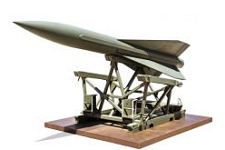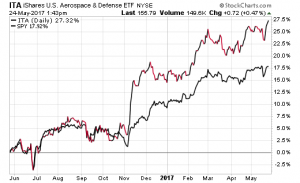3 Aerospace & Defense ETFs On The Move
 Right now, defense is hot, and these three funds covering the space are among the leading ways to buy in
Right now, defense is hot, and these three funds covering the space are among the leading ways to buy in
Sometimes you stumble across a sector of the market that is just in the right place at the right time. That may very well be the sentiment driving the remarkable price action in aerospace and defense stocks in the current geopolitical environment.
These companies are the driving forces behind military and commercial aircraft, defense equipment, and other services designed to support the armed forces.
Exchange-traded funds (ETFs) that track defense stocks tend to be more aggressive and potentially more volatile than the broader market based on their concentrated portfolios. Investors that are considering these tools should opt to take smaller, tactical positions compared to a traditional core holding with wider diversification and minimal expenses.
It also goes without saying that politics and global military trends are likely to have the biggest impact on the direction of these ETFs over the next several years. But for right now, all of the macroeconomic winds are on these funds’ side.
iShares U.S. Aerospace & Defense ETF (ITA)
Expenses: 0.44%, or $44 annually for every $10,000 invested
The largest and most well-known exchange-traded fund that tracks this group is the iShares U.S. Aerospace & Defense ETF (NYSEARCA:ITA).
This passively managed index fund has $2.9 billion dedicated to a short list of just 39 large-cap stocks including: Boeing Co (NYSE:BA), United Technologies Corporation (NYSE:UTX) and Lockheed Martin Corporation (NYSE:LMT).
ITA recently hit new all-time highs and is significantly outperforming the broader SPDR S&P 500 ETF (NYSEARCA:SPY) over the past 12 months.
The accompanying chart shows just how sharply this aerospace and defense took off after the 2016 election results as the expectation of additional military spending lurked on the horizon.
PowerShares Aerospace & Defense Portfolio (PPA)
Expenses: 0.64%
Another established fund in this class is the PowerShares Aerospace & Defense Portfolio (NYSEARCA:PPA). This ETF tales a slightly broader approach to its index construction criteria by including 52 defense stocks.
Many of the top holdings are similar to that of ITA — UTX, BA and LMT, along with General Dynamics Corporation (NYSE:GD) — although it does hold Honeywell International Inc. (NYSE:HON) at a substantial 7%, and there is greater differentiation in the bottom quartile of the portfolio. Still, this likely will only produce small variations in performance over longer cycles.
PPA charges a modestly higher expense ratio of 0.64% versus 0.44% in ITA. Cost is becoming an ever more important consideration when investors compare similar passively managed ETFs. Unless a higher-cost fund offers a distinctively unique strategy or enhanced liquidity, it’ likely to have diminished utility over the long-term.
SPDR S&P Aerospace & Defense ETF (XAR)
Expenses: 0.35%
The cheapest fund in this group is the youngest entrant in the SPDR S&P Aerospace & Defense ETF (NYSEARCA:XAR). This ETF debuted in 2011 and offers a different approach to the weighting of its constituents.
The 38 underlying holdings are derived from the aerospace & defense category of the S&P Total Market Index and equal weighted across the board. This provides smaller companies with a greater share of the fund’s assets and allows them to contribute meaningfully to performance. Hence, while UTX and GD are found in the top 10 holdings, so are $1.8 billion Triumph Group Inc (NYSE:TGI) and $2.5 billion KLX Inc (NASDAQ:KLXI).
XAR also charges the lowest expense ratio of its peers.
Note: David Fabian is the author of this article. David is Managing Partner and Chief Operations Officer of FMD Capital Management. To get more investor insights from FMD Capital, visit their blog.
See Also From InvestorPlace:
- 8 Dangerous Dividend Stocks That Could Cut or Kill Their Payouts
- 4 Tech Stocks to Buy Before They Ride AI to the Sky
- 5 Stocks to Sell in June
Category: ETFs





